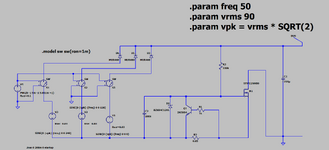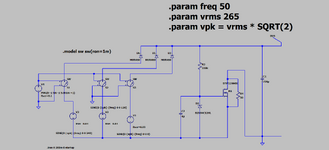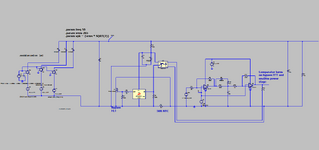cupoftea
Advanced Member level 5

Hi,
We are doing 130W Two Transistor forward. It comes after a three diode rectifier of
three phase mains, 100-265VAC.
We don't have PFC, so have a 220uF el cap after the rect, as you'd expect.
Before that, there is a 50 Ohm NTC. The problem is that at startup, it takes
2.5 seconds for the supply to get stabilised due to it dropping out repeatedly till the NTC
warms up. (this is likely to be worse at zero degc ambeint)
Similarly, if the supply goes to no load...then suddenly to full load, then obviously the NTC has cooled,
and so we get the 2.5 seconds of the supply repeatedly dropping out before it stabilises.
Our application cannot tolerate this.
The NTC is 50 Ohms because of the spec of up to 265VAC input. However, some customers only want it
for 115VAC. Therefore, for these customers, I believe we should make the NTC = [130V*SQRT(2)] / (373V/50R) Ohms
= 24 ohms.
Would you say this is the best/cheapest solution?
(Inrush relay and its isolated supply would stress the budget.)
But am pondering a low side "MOSFET_with_sense resistor and NPN gate pull down" circuit aswell...perhaps combining this with say a 4R7 NTC .
Having said that, i dont think FETs SOA is really up to it in most cases.....and would rather do it with a nice rugged IGBT.
We are doing 130W Two Transistor forward. It comes after a three diode rectifier of
three phase mains, 100-265VAC.
We don't have PFC, so have a 220uF el cap after the rect, as you'd expect.
Before that, there is a 50 Ohm NTC. The problem is that at startup, it takes
2.5 seconds for the supply to get stabilised due to it dropping out repeatedly till the NTC
warms up. (this is likely to be worse at zero degc ambeint)
Similarly, if the supply goes to no load...then suddenly to full load, then obviously the NTC has cooled,
and so we get the 2.5 seconds of the supply repeatedly dropping out before it stabilises.
Our application cannot tolerate this.
The NTC is 50 Ohms because of the spec of up to 265VAC input. However, some customers only want it
for 115VAC. Therefore, for these customers, I believe we should make the NTC = [130V*SQRT(2)] / (373V/50R) Ohms
= 24 ohms.
Would you say this is the best/cheapest solution?
(Inrush relay and its isolated supply would stress the budget.)
But am pondering a low side "MOSFET_with_sense resistor and NPN gate pull down" circuit aswell...perhaps combining this with say a 4R7 NTC .
Having said that, i dont think FETs SOA is really up to it in most cases.....and would rather do it with a nice rugged IGBT.
Last edited:





